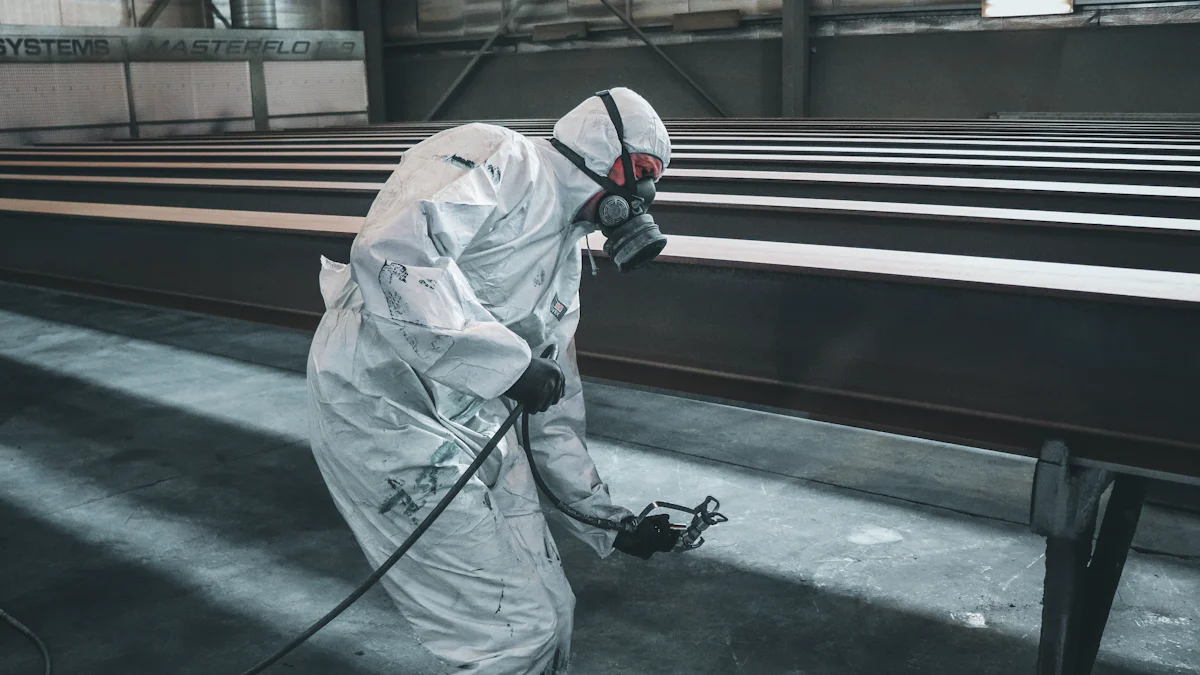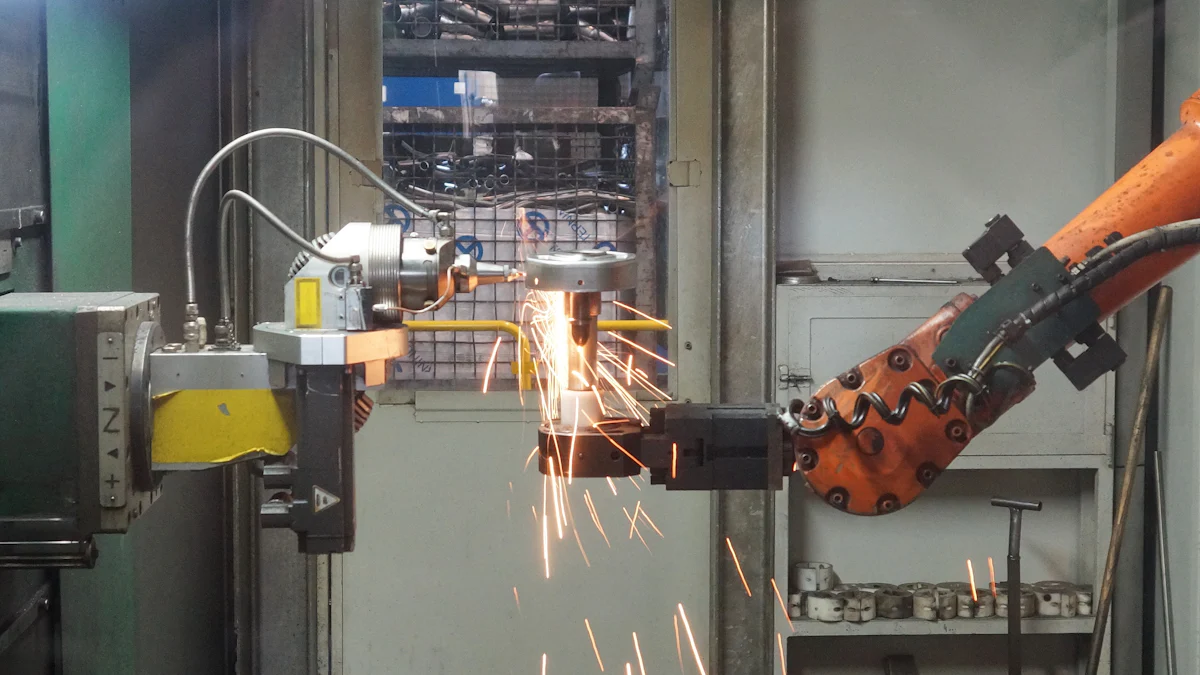炭化ケイ素(SiC)のコーティングは産業性能を高めるために必要であり、顕著な耐久性を通すことを提供します 優れた硬度、耐摩耗性、熱安定性お問い合わせ ザ・オブ・ザ・ CVDコーティングプロセス チャレンジングな環境で優れた結果を届けるために広く活用されています. インフォメーション SiCコーティング 極端な条件下でexcels, 2000°以上の温度に耐える フリガナ 急速な熱変動の間に安定性を維持し。 様々な材料との化学的安定性と互換性が重要視されています。 半導体製造や航空宇宙など、多岐に渡り信頼される インフォメーション SiCコーティンググラファイト 長持ちする信頼性および効率を保障するため.
要点
- インフォメーション SiCコーティングは例外的に提供します 熱安定性、それらに2000°上の高温産業適用、抵抗の温度のための理想を作る ツイート.
- これらのコーティングは驚くべき硬度および耐久性を、大気空間および半導体産業のような研摩の環境の成分の寿命を、かなり拡張します.
- インフォメーション SiCコーティングは、化学加工や半導体製造などの業界にとって重要な腐食性物質から基幹材料を保護する、化学的に不活性です.
- CVD SiCコーティングの優れた表面均一性は、一貫性のある性能と信頼性を確保し、重要な用途の欠陥の可能性を減らします.
- 適切なコーティング方法の選択は不可欠です。CVD SiCコーティングは、要求の厳しい環境で優れています。PVDや熱スプレーなどの耐久性と効率性を提供します.
SiCコーティング方法の概要
シリコンカーバイド(SiC)コーティングは、様々な先端技術、各提供のユニークな利点と制限を使用して適用されます。 これらの方法を理解することは、特定の産業用途に最も適したアプローチを選択するために不可欠です.
化学気相成長法(CVD)
について 化学蒸気蒸着プロセス シリコンと炭素含有ガスを反応室に導入することを含みます。 これらのガスは高温で分解し、基質に密で均一なSiCコーティングを形成します. このプロセスの重要なステップには、:
- 基質の準備: : : 不純物を取除くために基質をきれいにして下さい.
- 前駆者の紹介: : : ガス状シリコンと炭素化合物をチャンバーに導入.
- 化学反応: 高温での反応を促進し、炭化ケイ素を形成します.
- 入金方法:基板にSiC材料を堆積させます.
- 冷却および点検: コーティングされた基質を冷却し、質のためにそれを点検して下さい.
CVDはコーティングの特性上の精密な制御を提供します 複雑な形状に適しています。 但し、高コストを伴って、有害物質の取り扱いが必要です.
物理蒸着(PVD)
物理的な蒸気の沈殿は熱蒸発か真空条件の下スパッタを基質に沈むのに使用します。 コーティングの厚さおよび構成の高精度を保障するこの方法。 それは環境に優しく、最低の無駄を作り出します。 しかし、PVDは、不規則な形状の均一なカバレッジを達成するために、より遅い堆積率や課題などの制限があります.
| PVDの利点 | PVDの限界 |
|---|---|
| 精密な制御を用いる良質のコーティング | 高い真空環境を要求します |
| 動作温度を下げる | ラインの限界はコーティングの形を制限します |
| 最小廃棄物生産 | CVDと比較して、より低い堆積率 |
| 環境に優しい選択 | 大量生産に最適 |
熱スプレーのコーティング
熱スプレーのコーティングは基質に液体材料を吹き付け、保護層を形作るためにそれらを治すことを含みます。 この方法は、シンプルで費用対効果が大きいため、基本的な耐摩耗性を必要とする用途に最適です。 しかしながら、CVDやPVDと比較して、密着性が弱く、均一性が低下することが多い.
| Coating Method | 効率および適用 |
|---|---|
| 熱スプレー(大気プラズマスプレー) | 乾燥または潤滑条件下で低摩擦係数を達成し、耐摩耗性を大幅に向上させます. |
| 化学気相成長法(CVD) | 90%による摩耗率を大幅に削減、室温で最低の摩耗率を提供する密集したβ-SiC段階と. |
| 伝統法(梱包セメント) | 成熟した技術は、プロセス制御と低生産効率が欠けています。, 特に大きなまたは不規則なコンポーネント. |
各メソッドは異なる利点を提供しますが、 インフォメーション SiCコーティング 要求の厳しい環境で優れた性能を発揮します.
スパッタリングとプラズマコーティング法
スパッタリングおよびプラズマコーティング方式は、炭化ケイ素(SiC)コーティングを適用するための高度なソリューションを提供します。 これらの技術は、さまざまな基質にSiCの薄く、均一な層を堆積させるために高エネルギープロセスを利用します。 精密・適応性は、高度の表面特性を必要とする産業にとって価値あるものとなる.
スパッタリング方法
スパッタリングは、炭化ケイ素などの標的材料を爆破し、高エネルギーイオンを含む。 このプロセスは、ターゲットから原子を排出し、その後、基板上に堆積して薄膜を形成します。 精密な厚さ制御および優秀な付着のコーティングを作り出すことのスパッタリングのexcels。 滑らかで、欠陥なしの表面を要求する適用のために特に有効です。 しかしながら、そのラインオブザックの性質により、大小または不規則な形状の成分をコーティングする際の課題に直面する場合があります.
プラズマコーティング方法
プラズマコーティングは、イオン化ガスを使用して、SiCの堆積を容易にする高エネルギー環境を作成します。 耐摩耗性、硬度、耐摩耗性を高めます。 プラズマコーティングは、負荷下での摩擦を軽減し、高強度用途に最適です。 大気中のプラズマ噴霧、一般的な変形、低摩擦係数を達成し、極端な条件下での耐久性を改善します.
ユニークな特徴の比較
以下の表は、ユニークな特徴を強調します 他のSiCコーティング技術と比較してスパッタリングおよびプラズマコーティング方法の:
| Coating Method | ユニークな特徴 |
|---|---|
| 大気プラズマスプレー | 耐摩耗性、高硬度、耐摩耗性の向上、耐摩耗性の向上、耐摩耗性向上、耐摩耗性向上、耐摩耗性向上、耐摩耗性向上、耐摩耗性向上、耐摩耗性向上、耐摩耗性向上、耐摩耗性向上、耐摩耗性向上、耐摩耗性向上、耐摩耗性向上、耐摩耗性向上、耐摩耗性向上、耐摩耗性向上、耐摩耗性向上、耐摩耗性向上、耐摩耗性向上、耐摩耗性向上、耐摩耗性向上、耐摩耗性向上、耐摩耗性、耐摩耗性向上、耐摩耗性向上、耐摩耗性向上、耐摩耗性向上、耐摩耗性向上、耐摩耗性、耐摩耗性向上、耐摩耗性に優れ、耐摩耗性、耐摩耗性、耐摩耗性、耐摩耗性、耐摩耗性向上、耐摩耗性、耐摩耗性に優れ、耐摩耗性、耐摩耗性、耐摩耗性、耐摩耗性に優れ、耐摩耗性、耐摩耗性、耐摩耗性、耐摩耗性、耐摩耗性、耐摩耗性、耐摩耗性、耐摩耗性、耐摩耗性、耐摩耗性に優れ、耐摩耗性、耐摩耗性、耐摩耗性. |
| 化学気相成長法(CVD) | 90%による摩耗率を大幅に削減し、熱循環下での構造的整合性を維持します. |
| Traditional Methods | 成熟した技術、操作の容易さが、複雑な形状のプロセス制御と効率を欠いています. |
| 熱的にスプレーされたSiCのコーティング | 様々な条件下で低摩擦係数を達成. |
スパッタリングとプラズマコーティング方式は、航空宇宙や半導体などの業界に信頼性の高いソリューションを提供します。 表面特性を増強する能力は要求する環境の長続きがする性能を保障します.
CVD SiCコーティングの主な特性

高い熱安定性
インフォメーション SiCコーティングは驚くべき熱安定性を示す高温産業用途に欠かせない製品です。 これらのコーティングは、極端な熱と機械的ストレスの下で構造的完全性を維持し、要求の厳しい環境で信頼性の高い性能を保証します。 航空宇宙部品や半導体製造に重要な変形や割れに抵抗します.
研究では、CVD SiCコーティングの熱安定性がシリコンの共同分解によって著しく向上することを示しています。 このプロセスは高温アニールの後で硬度を高めます、と 400°までの露出の後の40 GPaまでの硬度のレベル ツイート. . 更に熱応力の下で耐久性をアンダーリング中にSiC相の結晶化。 また、熱衝撃に関連したリスクを最小限に抑え、急流時でも一貫した性能を保証します.
例外的な硬度および耐久性
インフォメーション SiCのコーティングは産業コンポーネントの寿命を延ばす例外的な硬度および耐久性のために有名です. さまざまな負荷(5,10,15N)で分岐計をスライドさせることで実施した実験 優れた耐摩耗性を発揮します。 これらのコーティングは、強靭な機械的特性を反映し、高ヤングの弾性率も展示しています.
スクラッチテストは、コーティングと基質の間の粘着強度をさらに強調し、機械的ストレス下での耐久性を保証します。 硬度と耐摩耗性の組み合わせにより、CVD SiCコーティングは、化学加工や航空宇宙産業などの研磨条件への長期暴露を必要とする用途に最適です.
化学成分
インフォメーション SiCコーティングは化学的に積極的な環境で加速します、腐食性の物質に対する保護障壁として役立つ。 高温でも構造特性を保持し、劣化から基材を保護します。 半導体製造や高温反応器などの業界では特に価値があります.
これらのコーティングはまた急速な温度変動の環境で例外的によく行います。 化学腐食に対する抵抗は、船舶工学や化学加工などの用途で機能性を高めます。 積極的な物質に対するシールドとして機能することにより、CVD SiCコーティングは、過酷な条件での長期的信頼性と効率を保証します.
優秀な表面の均等性
インフォメーション SiCコーティングは、優れた表面均一性、高性能産業用途の重要な特性を発揮します。 この均等性は一貫した機能性を保障し、要求する環境のコンポーネントの信頼性を高めます.
化学蒸気蒸着プロセスは、コーティングの厚さと組成を制御することで比類のない精度を実現します。 このレベルの制御結果は、基板にシームレスに付着する密で欠陥のない構造です。 熱スプレーやスパッタリングなどの他の方法とは異なり、CVDは、不均等または多孔性のコーティングのリスクを最小限に抑えます。 これらの欠陥は、産業コンポーネントの性能と耐久性を損なうことができます.
CVD SiCコーティングの密で均一な構造は滑らかな表面の終わりを提供します、それは最低の摩擦か高い光学明快さを必要とする適用のために必要です。 半導体や光学系などの業界は、最適な性能を発揮し、運用中の欠陥の可能性を低減するなど、この特性から大きな利益をもたらします.
CVD SiCコーティングの優れた表面均一性に貢献する主な要因は次のとおりです
- コーティングの厚さおよび構成上の精密な制御.
- 欠陥のない密で均一な構造を形成する能力.
- 代替方法によって生成されたコーティングでしばしば観察される気孔の排除.
CVD SiCコーティングの均一性はまた複雑な幾何学との両立性を高めます。 この適応性は、航空宇宙および半導体製造で使用される複雑なコンポーネントに適しています。 表面不規則性がないことは、極端な条件下であっても、一貫した性能を保証します.
比較では、他のコーティング方法は、同じレベルの均一性を達成するために苦労することがあります。 たとえば、熱スプレーコーティングは、スプレープロセスの性質上、凹凸面が生じることが多いです。 同様に、スパッタリングは、コーティングの大部分または不規則な形状のコンポーネントの課題に直面している可能性があります。 これらの限界は産業適用のCVD SiCのコーティングの異なった利点を強調します.
CVD SiCコーティングの優れた表面均一性は、産業コンポーネントの性能を向上させるだけでなく、運用寿命を延ばします。 このプロパティは、近代産業の厳しい要求を満たすCVD技術の値をアンダースコアします.
SiCコーティング法の比較解析
高温の下の性能
CVD対PVD
CVD SiC coatings インフォメーション 高密度結晶構造による高温環境でのPVDコーティング。 この構造は、優れた硬度と耐摩耗性を提供し、CVDコーティングを可能にし、1,000度の摂氏を超える温度でその完全性を維持します。 一方、PVDコーティングは、熱または腐食性の化学薬品への延長された露出の下でよりすぐに劣化します。 これらの制限は、長期熱安定性を必要とするアプリケーションに適したPVDを少なくします.
CVDのコーティングはまた急速な温度の変動の間に一貫した性能を保障する熱衝撃に抵抗します。 このプロパティは、航空宇宙や半導体製造などの業界にとって重要な要素であり、コンポーネントは極端な熱的ストレスに直面しています。 PVDのコーティングは、厚さ制御で精密な間、そのような要求する条件のために必要な堅牢性を欠きます.
CVD対熱スプレー
インフォメーション SiCコーティングは熱スプレー方法と比較して優秀な熱安定性を提供します。 熱スプレーのコーティングは頻繁に高温に抗する能力を妥協する気孔率を示します。 対照的に、CVDのコーティングは変形および極度な熱の下で割れることに抵抗する密で、均一層形作ります.
サーマルスプレー方式は、要求の厳しい用途に十分な場合がありますが、高温への長期暴露を必要とする環境では不足します。 CVDのコーティングは耐久、耐熱性材料を必要とする企業のための信頼できる解決を提供します.
Durability and Wear Resistance
CVD対PVD
インフォメーション SiCコーティングは耐久性と耐摩耗性に優れ、高強度用途に最適です。 優れた密着性と均一性を発揮し、長持ちする性能を保証します。 トリボロジー検査では、CVDコーティングがPVDコーティングと比較して大幅に摩耗率が低下し、機械的ストレス下での劣化が著しいことを明らかにしています.
- CVDのコーティングは研摩の条件の摩耗を減らす例外的な硬度を提供します.
- PVDのコーティングは、精密で、粗い環境のCVDのコーティングの堅牢性を欠きます.
| コーティング・タイプ | 負荷(N) | 摩耗の容積(mm3) | 特定摩耗率(mm3/(N・m))) |
|---|---|---|---|
| CVD-SiC | 5 | 〒107-0052 東京都港区赤坂1-12-32 | 8.0×10−6 |
| CVD-SiC | 15 | 4.37×10−3 | 8.0×10−6 |
| APS-SiC | 5 | 0.072 | 4.02×10−4 |
| APS-SiC | 15 | 0.399 | 7.39 × 10−4 |
インフォメーション 対. スパッタリングとプラズマコーティング
耐摩耗性や耐久性にスパッタリングやプラズマ法を上回るCVDコーティング。 スパッタリングは、優れた粘着で薄膜を生成しますが、複雑な幾何学の均一性に苦労します。 プラズマコーティングは表面硬度を改善しますが、CVDコーティングの密度と構造的完全性が欠ける可能性があります.
インフォメーション SiCのコーティングは機械圧力および摩耗に抗する密で、欠陥なしの層を提供します。 長期的な信頼性を必要とする用途に好まれる選択肢となります.
アプリケーション固有の利点
Semiconductor Industry
インフォメーション SiCコーティングは、半導体製造に比類しない利点をもたらします
- 高温プロセスにおける優れた熱安定性.
- 化学抵抗 腐食性のガスおよび化学薬品に対して.
- 超滑らかな表面の終わりは、汚染の危険を最小にします.
- 重要なコンポーネントの寿命を延ばし、ダウンタイムとメンテナンスコストを削減します.
これらの特性は精密および信頼性を保障します、半導体装置の質を高めます.
航空宇宙・防衛
インフォメーション SiCのコーティングは大気および防衛適用のための独特な利点を提供します:
- 比類のない耐久性および熱抵抗.
- 軽量性、重みのない性能を高める.
- 摩耗、腐食および極度な温度からの保護.
これらのコーティングは、タービンブレードのような重要なコンポーネントの効率を改善し、極端な環境での長期信頼性を保証します.
化学加工
インフォメーション SiCコーティングは化学処理の重要な課題に対処します:
- 優れた熱安定性、高温での構造特性を保持します.
- 腐食性物質に対する障壁として作用する高い耐薬品性.
- 耐久性、要求の厳しい適用の耐久性を保障します.
これらの特徴は、過酷な化学環境で使用される機器に不可欠なCVDコーティングをします.
CVD SiCコーティングの産業適用

半導体製造
インフォメーション SiCコーティングは、重要なコンポーネントの性能と長寿を高めることで、半導体製造において重要な役割を果たしています。 これらのコーティングは例外的な熱安定性を提供し、装置がウエハ処理の間に要求される高温に抗することを可能にします。 それらの化学抵抗は腐食性ガスや化学物質から保護し、ツールの完全性を確保し、メンテナンスニーズを軽減します.
CVD SiCコーティングの超滑らかな表面仕上げは、半導体製造に必要な精度を維持するために重要な汚染リスクを最小限に抑えます。 さらに、耐久性はコンポーネントの寿命を延ばし、ダウンタイムを削減し、全体的な効率を改善します。 これらの特性は、高品質の半導体デバイスの製造に欠かせないCVD SiCコーティングをします.
航空宇宙部品
インフォメーション SiCコーティングにより、航空宇宙部品の性能を大幅に向上 耐久性と耐摩耗性を極端に向上させることで、 これらのコーティングは酸化および腐食から重要な部品を保護します、高速および高温条件の間に信頼できる操作を保障します.
- 航空宇宙部品の耐久性を高め、摩耗を減らし、破損します.
- 酸化および腐食への抵抗は環境損傷から重要な部品を保護します.
- 高速運転中でも、極端な応力を発揮します.
インフォメーション SiCコーティングは、タービンブレードや熱シールドに特に有効で、熱抵抗と軽量特性が不可欠です。 比類のない耐久性と熱安定性を提供することで、これらのコーティングは、不要な重量を加えることなく、航空宇宙システムの効率性と安全性に貢献します.
Chemical Processing Equipment
インフォメーション SiCコーティングは、化学加工環境に優れています 極端な温度と過酷な化学物質に耐える能力のため。 高熱を弱める金属とは異なり、これらのコーティングは構造的完全性を維持し、長期的な信頼性を保証します。 耐薬品性は、腐食性物質から基材を保護し、エネルギー生産や半導体製造などの産業で使用される機器に不可欠です.
CVD SiCの高い純度および異方性立方構造は優秀な硬度を提供します 高エネルギープラズマによる腐食への抵抗 この耐久性は、鏡面仕上げと組み合わせ、要求の厳しい用途で最適な性能を保証します。 これらのコーティングは熱衝撃に抵抗し、それらに急速な温度の変動の環境にとって理想的にします。 過酷な条件に耐える能力は、CVD SiCコーティングは、化学加工機器の好ましい選択肢になります.
光・光デバイス
インフォメーション SiCのコーティングは光学およびフォトニクス装置の分野の変形の解決として出ました。 高い熱安定性、化学的不活性、優れた表面均一性を含む独自の特性は、高度な光学用途に不可欠です。 これらのコーティングは部品の性能そして耐久性を高め、要求する環境の信頼性を保障します.
CVD SiCコーティングの最も重要な適用の1つは光学導波路にあります。 これらの導体は、シリコンカーバイドコア内の光を絞り込み、最小の伝搬損失で効率的な光伝送を可能にします。 この低損失特性により、SiC の導波ガイドは、他の主要な材料プラットフォームに匹敵します。 また、SiCOI(シリコンカーバイド・オン・インシュレータ)のスタックの開発は、光学機器の製造の礎となりました.
お問い合わせ: : : SiCOIスタックは、SiCをフォトニクス回路に統合し、コンパクトで効率的な光学システムの作成を可能にするために不可欠です.
インフォメーション SiCコーティングは、フォトニック集積回路(PIC)でもピボタル役割を果たしています。 これらの回路は、ビームスプリッタ、変調器、周波数櫛などのSiCベースのコンポーネントを利用します。 コーティングは高性能のフォトニクス装置のために不可欠である精密な軽い操作を保障します.
導波路を超えて、SiCは非線形光学特性に注目しています。 研究者は、量子計算と安全な通信システムにおける重要な要素である、単一のフォトンソースとしてその可能性を探求しています。 SiCを用いて製造された高品質のマイクロリング共振器は、光信号処理において優れた性能を発揮します.
| Application | 機能性 |
|---|---|
| 光学導波ガイド | 光と光の融合 低い伝搬損失. |
| 光子集積回路 | ビームスプリッタやモジュレータなどのコンポーネントは、効率的な光操作を実現します. |
| 非線形光学適用 | 高度な光学系のためのシングルフォトンソースとマイクロリング共振器. |
また、高効率GaN系LED用基板としてSiCを採用しています。 これらのLEDはエネルギー効率の高い照明および表示技術のためにそれらに理想的にする高められた光放射から寄与します。 CVD SiCコーティングの汎用性は、急速に進化する光学および光産業における継続的な関連性を保証します.
光学機器へのCVD SiCコーティングの統合は、性能を向上させるだけでなく、量子技術や高速通信システムにおけるイノベーションの方法もカバーします.
インフォメーション SiCコーティングは、極端な温度抵抗、熱衝撃弾性、および例外的な硬度を組み合わせた、産業用途に比類のない利点を提供します。 これらのコーティングは、耐久性と持続可能性を確保しながら、腐食と酸化から保護します。 以下の表は、独自の特性を強調します
| プロパティ | 説明 |
|---|---|
| 極端な温度抵抗 | インフォメーション SiCコーティングは温度に抵抗します 2000°以上 フリガナ、高力適用のために適した. |
| Thermal Shock Resistance | 装置の寿命を延ばす急速な温度変化からの損傷を防ぎます. |
| フリガナ | コーティングの硬度のライバルのダイヤモンドは、要求する環境の耐久性を保障します. |
| 化学安定性 | 厳しい産業条件のために重要な腐食および酸化から保護して下さい. |
| 低い電気抵抗 | 電子部品の性能を高め、信頼できる伝導性を保障します. |
| Durability | 少ない交換と修理で廃棄物を減らすことで、持続可能性に貢献します. |
| リサイクルとの互換性 | 被覆材の再利用を可能にし、循環経済をサポートします. |
適切なコーティング方法を選択すると、特定のアプリケーションでのパフォーマンスの最適化に不可欠です。 インフォメーション SiCコーティングは精密、耐久性および熱安定性を要求する企業のExcelを包みます。 適応性は、多様な分野における信頼性の高い性能を保証します.
CVD SiCコーティングの未来は巨大な約束を保持します。 原子炉技術の進歩と新しい前駆材料は、その使用を拡大します 空間ベースの光学システム 衛星コンポーネント。 これらのコーティングは、再生可能エネルギー技術の重要な役割を果たし、強化します ソーラーパネルや風力タービンの耐久性 メンテナンスコストを削減しながら。 原子力発電所の保護特性は、安全性と効率性を確保する可能性をさらに強調しています.
インフォメーション SiCコーティングは、宇宙探査、再生可能エネルギー、そしてそれを超えて革新する方法を舗装し、産業基準を赤化し続けます.
よくあるご質問
CVD SiCコーティングは、他のコーティング方法よりも優れていますか?
インフォメーション SiCコーティングは、比類のない熱安定性、耐摩耗性、耐薬品性を提供します。 緻密で均一な構造により、耐久性と信頼性を極端に保ちます。 これらの特性は、航空宇宙、半導体、化学加工などの高性能材料を必要とする業界に理想的です.
CVD はできます SiCコーティングは急速な温度変化に耐えますか?
はい、CVD 耐衝撃性に優れたSiCコーティング。 温度の変動が急激に変化し、一貫した性能を発揮します。 このプロパティは、航空宇宙コンポーネントや 半導体製造、材料が極端な熱応力に直面しているところ.
環境に優しいCVD SiCコーティングはありますか?
インフォメーション SiCコーティングは、産業コンポーネントの寿命を延ばすことにより、持続可能性をサポートします。 耐久性は無駄を減らし、交換の必要性を最小限に抑えます。 また、リサイクルプロセスとの相性は、循環型経済に貢献し、さまざまな産業の環境にやさしい選択をしています.
CVD SiCコーティングは半導体製造にどのように貢献しますか?
インフォメーション SiCコーティングは例外的な熱安定性、化学抵抗および表面の均等性を提供することによって半導体の製造を高めます。 これらの特性は、ウェーハ処理中の精度を確保し、汚染リスクを削減し、重要なツールの寿命を延ばし、全体的な効率と製品品質を向上させます.
CVD SiCのコーティングからほとんどの企業の利点は何ですか?
航空宇宙、半導体、化学加工、光学などの産業は、著しく利益をもたらします。 これらのコーティングは耐久性、熱抵抗および化学安定性を改善し、要求する環境の信頼できる性能を保障します。 多様性は、多様な分野にわたって高性能なアプリケーションに不可欠です.